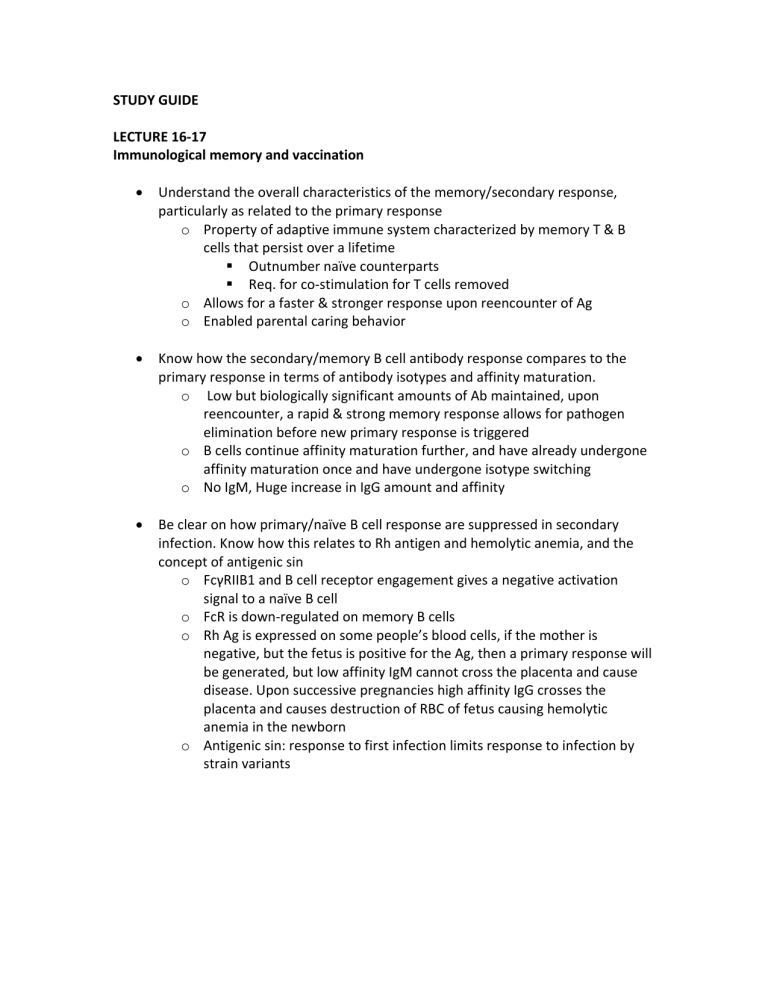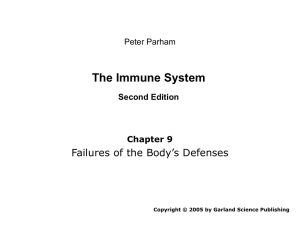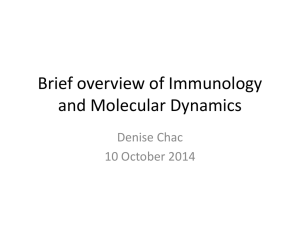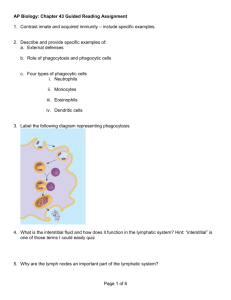
STUDY GUIDE LECTURE 16-17 Immunological memory and vaccination • Understand the overall characteristics of the memory/secondary response, particularly as related to the primary response o Property of adaptive immune system characterized by memory T & B cells that persist over a lifetime § Outnumber naïve counterparts § Req. for co-stimulation for T cells removed o Allows for a faster & stronger response upon reencounter of Ag o Enabled parental caring behavior • Know how the secondary/memory B cell antibody response compares to the primary response in terms of antibody isotypes and affinity maturation. o Low but biologically significant amounts of Ab maintained, upon reencounter, a rapid & strong memory response allows for pathogen elimination before new primary response is triggered o B cells continue affinity maturation further, and have already undergone affinity maturation once and have undergone isotype switching o No IgM, Huge increase in IgG amount and affinity • Be clear on how primary/naïve B cell response are suppressed in secondary infection. Know how this relates to Rh antigen and hemolytic anemia, and the concept of antigenic sin o FcγRIIB1 and B cell receptor engagement gives a negative activation signal to a naïve B cell o FcR is down-regulated on memory B cells o Rh Ag is expressed on some people’s blood cells, if the mother is negative, but the fetus is positive for the Ag, then a primary response will be generated, but low affinity IgM cannot cross the placenta and cause disease. Upon successive pregnancies high affinity IgG crosses the placenta and causes destruction of RBC of fetus causing hemolytic anemia in the newborn o Antigenic sin: response to first infection limits response to infection by strain variants § • I.e. influenza virus Know the difference between effector memory T cells (TEM) and central memory T cells (TCM) o o TCM : have a low activation threshold and high potential for IL-2 production, proliferation and rapid differentiation into effector cells o TEM : Express chemokine receptors that allow entry into tissues, allowing for an immediate effector response but limited proliferation • Know the historical origins of vaccines (when were they introduced, by whom, where does the word vaccine come from?) o Variolation (intro of small amt of lesion matl) against smallpox was practiced 1000 years ago in china o Edward Jenner in 18th century England experimentally showed that inoculation with cowpox/vaccinia virus induced resistance to smallpox, but was harmless and self-limiting in humans § Hence the term vaccination • Understand the major differences between live/attenuated and killed/inactivated vaccines o Killed/Inactivated: inactivated by chemical treatment (formalin) or physical (heat/irradiation) § Treatment must reliably inactivate viral nucleic acid, and large amounts of pathogenic virus are needed for production § Tend to not be as effective as a live vaccine, but do not cause any ill-effects o Live/attenuated: some limited infection and viral replication will stimulate an immune response § § Isolated from patient and grown in culture, then used to infect monkey cells in which it acquires mutations to grow in the cells, but it no longer grows well in human cells and is used as a vaccine Possible low level virulence • Be familiar with the limitations of vaccines o No effective vaccine against chronic infectious diseases o Look at second sub bullet for major differences* • Know the meaning of a conjugate vaccine and how they work o Carb Ag linked to Protein Ag which allows linked recognition to allow T cells to provide help for B cell Ab response § Ex) meningococcus vaccine - was not very effective due to lack of T cell response due to it being made of purified Carb Ag • Conjugation to protein Ag allowed T cell response to be incorporated into vaccine response • Understand why adjuvants are useful in vaccines o Act by stimulating innate immune response and are mixed with protein Ag to boost immunogenicity o Provides danger signals, thus allowing for T cell activation o Many in development are TLR ligands • What is the difference between forward and reverse vaccinology? o FWD: isolate organism, inactivate by preserve immunogenicity, inject into experimental animals and test for protection § Req. ability to isolate and grow organism o REV: Genomic sequence of pathogen, ID candidate Ag using bioinformatics, Produce purified Ag and test for protection § Does not req. pre-existing knowledge of pathogen • Know the major characteristics of influenza virus. Why is influenza such a problem if we have a vaccine available? o Replication of viral RNA is error-prone, leading to a high rate of mutations resulting in different strains § Causes vaccines to become ineffective o Target of Ab response is mainly hemagglutinin (H) and neuraminidase (N) • Know the meaning of herd immunity o Majority of population vaccinated allows few that are nonvaccinated to be protected due to lack of susceptible hosts to maintain reservoir of infection. • Understand why we encounter problems with making vaccines to pathogens causing chronic infection o Most vaccines work against pathogens that can normally be controlled by the immune system o Those that cause chronic disease do not elicit very effective immunity § Many have mechs to actively suppress immunity § Antigenic variation can interfere with immunity and vaccination § Parasitic diseases difficult to vaccinate due to complexity of organisms and that they are relatively closely related to us LECTURE 18-19 Co-evolution of innate and adaptive immunity • Know how ADCC (antibody dependent cellular cytotoxicity) works in NK cells o Antibody-dependent cellular cytotoxicity (ADCC) o NK cell recognizes bound anti-CD20 Ab which cross-link and signal the NK cell to kill the coated cell • What are the major similarities and differences between NK cells and CD8 T cells o CD8: differences § Gene rearrangement to make TCR § Activated by specific Ag § Proliferation and differentiation to acquire effector function o NK: differences § Primitive lineage of lymphocyte like cells § No gene rearrangement, no TCR, but do Express a large panel of activating and inhibitory receptors § Leave bone marrow ready to function o Similarities: § Use perforin/granzymes to kill § Secrete IFN-γ • Know the two ways to activate an NK cell (do not concern yourself with the specific names of the activating receptors) o Signals from two of more activating receptors o FcR binds with IgG which is sufficient enough to activate the NK cell • Understand the overall expression pattern of inhibitory and activating receptors on NK cells o Each NK cell expresses a subset of the 30 different activating and inhibitory receptors § All NK cells express an inhibitory receptor for self MHC 1 • Also express CD56 • Know how HLA-E works as an indicator of MHC class I expression, and the NK cell receptor involved in recognition, and how this results in target cell killing when the appropriate signals are delivered o HLA-E has a specificity for leader peptides of HLA-A, -B, or -C and it is not transported to the surface without bound peptide, thus the HLA-E on the cell surface is indicative of the amount of MHC1 expressed o CD94:NKG2A recognizes HLA-E and sends an inhibitory signal to the NK cell § HLA-E production is reduced in stressed and malignant cells o Stress proteins (expressed by sick or infected cells) engage NKG2D with another activating receptor which activates the Vav which activates the cytotoxic func. of the NK cell • Understand the general properties of KIRs, how they are expressed, and how they work with CD94:NKG2A as sensors of MHC class I o KIRs is another way NK cells monitor MHC1 levels by recognizing haplotype specific MHC determinants § This allows for monitoring of specific MHC loci or allotypes which can be decreased in infected cells and tumors but does not always correlate with a overall decrease in MHC levels that would be recognized as out of the learned parameters • What is the evidence for pathogen driven NK cell responses? o CMV a common infection in humans (co-evolved together) § Suppresses CD8 T cell response by preventing MHC presentation of viral peptides § Due to MHC 1 down regulation, this makes the infected cells susceptible to NK killing • Know the key differences between gd T cells and conventional ab T cells o γδ are found more abundantly in tissues like skin and intestinal epithelium § do not undergo negative or positive selection and are produced in waves to seed the periphery tissues where they reside § Have a small repertoire of V gene segments in germline § Do not express CD4 or CD8 § Self proteins resemble MHC 1 and non-peptide small molecules presented by MHC 1-like and other cell surface proteins § Present in tissues in a form that is quick to respond to infection and other forms of stress § Aid with tissue homeostasis: surveillance, protection and repair • Understand how BTN3A1 presents phosphoantigen to Vg9d2 T cells o BTN3A1 is related to B7, and is expressed in many cell types, does not req. costimulation to activate the γδ T cell o • Know how CD1d is involved in presenting lipids to Vgd1 T cells o The Vδ1 recognizes and binds the lipid which is presented by CD1d § CD1d can be endocytosed, self lipid can be exchanged for the internalized bacterial lipid and then CD1d is recycled to the surface for presentation • Know the properties of the three types of ab T cells restricted by nonconventional MHC molecules. This includes knowing the types of antigens recognized, the antigen presenting molecules, and which cells have a restricted TCR repertoire (but not the exact usage of V and J genes) o CD1a/b/c-restricted αβ T cells § Can be CD4 or CD8 positive • CD1a-c expressed by professional APC which are also targets of mycobacterial infection § Ag: mycobacterial lipids and other non-peptides § TCR repertoire: Diverse o NKT cells § Can be CD4 or CD8 positive • Recognize lipids bound by CD1d • Rapid activation • Reminiscent of innate immune receptor § Ag: Lipids and other non-peptides § TCR repertoire: Limited o MAIT cells § Present in mucosal tissues and liver • Differentiation depends upon exposure to microbiota, accumulate with age § Ag: Small heterocyclic organic molecules made by bacteria and fungi during riboflavin synthesis • Presented by MR1 § TCR repertoire: Limited LECTURE 20-21 When Host Defense Fails • Know the underlying causes of Ommen syndrome, APCED, PEX syndrome and Xlinked aggamglobulinemia o MBL deficiency: results in susceptibility to Neisseria meningitidis o Ommen syndrome: No functional RAG1 or RAG2 § Inability to recombine Ab and TCR gene segments halting T and B cell development leaving one susceptible to many infections o APCED: Lack of a functional AIRE (autoimmune regulator) § Widespread autoimmune disease affecting several tissues o IPEX syndrome: Lack of FoxP3 § Leading to immunodysregulation, polyendocrinopathy, enteropathy and X-linked syndrome o X-linked agammaglobulinemia(XLA): Defect in Bruton’s Tyr Kinase § Leaves one susceptible to bacteria normally controlled by opsonizing Ab • What is the Red Queen Hypothesis, and how does it relate to the relationship between pathogen and host? o Evolution of host to recognize essential components of invader, invader under evolutionary pressure to escape recognition under constraint of function § Don’t really get anywhere § Evolutionary arms race • Know the four major strategies that pathogens use to deal with the immune system (moving target, location, subversion, create confusion), including the specific examples discussed o Moving Target: § Antigenic drift: Error-prone replication causing mutation and emergence of new strains being a common phenomenon. • Ex) Influenza virus: epidemics due to emergence of a new strain causing widespread but localized infection causing mild symptoms § Antigenic Shift: Genetic re-assortment yielding a new strain to which the entire human population is vulnerable • Ex) Human and avian flu infects pig and then leads to a pandemic o Spanish flu, H1N1 2009 pandemic § Antigenic variation: Variation in surface coat that triggers a strong Ab response but changes periodically to escape the immune response • Ex) T. brucei which causes “African sleeping sickness” o Covered in surface coat of VSG which triggers a strong immune response and changes periodically to escape the immune response o Location § Hiding from the immune response allowing an infection to occur over and over • Ex) Herpesviruses which hide in neurons due to low levels of MHC1 and can be reactivated by stress, hormonal changes, the sun and this leads to the virus leaving the neuron and re-infecting epithelial cells • Ex) Chickenpox – cause of Shingles o Subversion § Prevention of the MHC1 presentation pathway to subvert a CD8 response (return to cytosol for degradation or by blocking the TAP peptide transporter • Ex) M. tuberculosis which enters macrophages and blocks the phagosomal-lysosomal fusion pathway • Ex) Listeria monocytogenes which enters a macrophage through a phagosome but escapes into cytoplasm • Ex) M. marinum does the same as listeria o Create Confusion § Cause of widespread T cell activation and cytokine overproduction • Staphylococcal enterotoxins secreted by S. aureus which cause many foodborne illnesses • SuperAg bind the Vβ chain of the αβ TCR and MHC2 to cause this response o Activate large families of CD4 based upon common Vβ gene • Understand the meaning of antigenic drift, antigenic shift and antigenic variation o Antigenic drift: Error-prone replication causing mutation and emergence of new strains being a common phenomenon o Antigenic Shift: Genetic re-assortment yielding a new strain to which the entire human population is vulnerable o Antigenic variation: Variation in surface coat that triggers a strong Ab response but changes periodically to escape the immune response • Know the general characteristics of AIDS (causes, origin, scope of disease) o Causes: HIV-1 (most prevalent) and HIV-2 (less virulent) o Origin: HIV-1 (Chimps) and HIV-2 (sooty mangabeys) o Scope: Major reduction in CD4 cells, severe infections by normally innocuous (opportunistic) pathogens, Kaposi’s sarcoma • Know the characteristics of the HIV virus. Life cycle, receptors it uses to enter cells o A retrovirus which is an RNA virus that integrates its nucleic acid into the host cell genome as a provirus with the aid of reverse transcription o A lentivirus – slowly progressing retrovirus o Cannot be eliminated by the host immune system o Is an exogenous retrovirus o Life Cycle § Virion binds CD4 with gp120 and co-receptor (CCR5 or CXCR4) so the viral envelope can fuse with the cell membrane § Reverse transcriptase creates dscDNA so the cDNA can integrate into the host DNA § T cell activation induces transcription of the provirus which is then sliced allowing for amplification of the viral RNA § The viral RNA associates with the virion which buds off from the cell • What happened to the US hemophiliac population when HIV entered the population? o Blood supply contaminated with HIV, leading to a large number of hemophiliacs becoming infected, many died o This showed that HIV progresses to AIDS inevitably • Know the role of CCR5 in HIV infection, and how its deletion affects AIDS o CCR5 is a co-receptor that aids with the viral envelope fusing with the cell membrane so that HIV can infect a cell o Its deletion prevents HIV from effectively infecting host cells thus conferring HIV resistance • Know the strategies for drug treating HIV o Drugs target the virus reverse transcriptase and protease § Single drug limits its effectiveness because this will select for drug resistant variants o Highly active anti-retroviral therapy (HAART) § Allows for the virus to be hit hard at multiple sites allowing variants to also be targeted § This must be maintained for the life of the individual due to long lived lymphocytes (macrophages, DC, T cells) • Be familiar with the concept of broadly neutralizing antibodies during HIV infection o A possible way to treat HIV § Target would be gp120 o Allows for the Ab response to be effective against multiple variants of HIV o Some are polyreactive, composed of different Ab fine specificities that bind different Ag determinants favoring efficiency in cross linking


